 Judith Beveridge’s Hook and Eye is a collection of previously published poems selected to showcase the highly regarded Australian poet’s work to an American readership. The poems are for the most part imaginatively — rather than autobiographically — conceived, lyrical while still remaining largely outward looking, and full of the sensual imagery and sound-play for which Beveridge’s work is prized. Yet what is most striking about the book, comprised of work written over a twenty-five year span, are the enduring and distinctive spiritual concerns of the poet, and how these inform her praxis.
Judith Beveridge’s Hook and Eye is a collection of previously published poems selected to showcase the highly regarded Australian poet’s work to an American readership. The poems are for the most part imaginatively — rather than autobiographically — conceived, lyrical while still remaining largely outward looking, and full of the sensual imagery and sound-play for which Beveridge’s work is prized. Yet what is most striking about the book, comprised of work written over a twenty-five year span, are the enduring and distinctive spiritual concerns of the poet, and how these inform her praxis.
As Maria Takolander points out in a recent review[i], the book’s first poem, ‘Girl Swinging’, seems deliberately placed to give the reader insight into (perhaps even guidance for entering) the poet’s creative practise.
I often think about
the long process that loves
the sound we make.
It swings us until
we’ve got it by heart;
the music we are.
(‘Girl Swinging’)
The process of creation rather than the creation itself is paramount, a process which (like Beveridge) ‘loves’ playing with ‘the sound we make’ and which ‘swings us’ until we come to understand, at a heart level, ‘the music we are’. There is a profound desire for personal transformation: the speaker, longing ‘to be a symphony / levitated by grace-notes’, turns quietly within, ‘listening to myself’ until ‘that feeling comes / of being lifted into the air’. Takolander has convincingly argued that lyric poetry is fundamentally a poetry of embodiment and senses a paradox here in the way the remembered sensations of the girl’s body ‘swinging’ generate the adult speaker’s spiritual disembodiment. Yet it is not merely sensory experience which leads to this state – it is the poet’s attentive focus upon the girl’s sensory experience which foreground a form of mindfulness and lead the narrator of ‘Girl Swinging’ to her own kind of lyric elevation. Beveridge’s poetry could perhaps be called a poetry of conscious embodiment; here, physicality acts as tool for deepening the narrator’s awareness until she rises into a space of ‘…clear singing / …above / the common rattle / of chains’.
You can read the rest of the review over at Mascara. My thanks to editor Michelle Cahill.

Comments 0
Hmm. 2 Books on my list, yours first. Experiencing a bout of unemployment however as soon as I am back in swing.
In depth review. It’s appreciated…
Author
Thanks so much for reading, Tanyeno. I’m sorry to hear you’ve not had luck finding a job! My best wishes. x
Michele,
Thanks so much. I now believe, I have to apply myself in a different way. So tomorrow, I begin that game. 🙂
I wonder if Judith Beveridge chose the selection of poems for the book herself? I will head over and read the rest of this review.
Author
That’s a good question, Penelope! One I never considered. Bad reviewer! Thanks for reading.